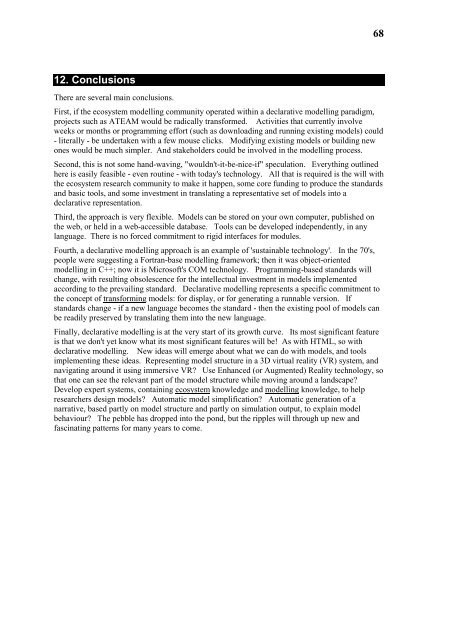pdf: 600KB - Potsdam Institute for Climate Impact Research
pdf: 600KB - Potsdam Institute for Climate Impact Research
pdf: 600KB - Potsdam Institute for Climate Impact Research
Create successful ePaper yourself
Turn your PDF publications into a flip-book with our unique Google optimized e-Paper software.
68<br />
12. Conclusions<br />
There are several main conclusions.<br />
First, if the ecosystem modelling community operated within a declarative modelling paradigm,<br />
projects such as ATEAM would be radically trans<strong>for</strong>med. Activities that currently involve<br />
weeks or months or programming ef<strong>for</strong>t (such as downloading and running existing models) could<br />
- literally - be undertaken with a few mouse clicks. Modifying existing models or building new<br />
ones would be much simpler. And stakeholders could be involved in the modelling process.<br />
Second, this is not some hand-waving, "wouldn't-it-be-nice-if" speculation. Everything outlined<br />
here is easily feasible - even routine - with today's technology. All that is required is the will with<br />
the ecosystem research community to make it happen, some core funding to produce the standards<br />
and basic tools, and some investment in translating a representative set of models into a<br />
declarative representation.<br />
Third, the approach is very flexible. Models can be stored on your own computer, published on<br />
the web, or held in a web-accessible database. Tools can be developed independently, in any<br />
language. There is no <strong>for</strong>ced commitment to rigid interfaces <strong>for</strong> modules.<br />
Fourth, a declarative modelling approach is an example of 'sustainable technology'. In the 70's,<br />
people were suggesting a Fortran-base modelling framework; then it was object-oriented<br />
modelling in C++; now it is Microsoft's COM technology. Programming-based standards will<br />
change, with resulting obsolescence <strong>for</strong> the intellectual investment in models implemented<br />
according to the prevailing standard. Declarative modelling represents a specific commitment to<br />
the concept of trans<strong>for</strong>ming models: <strong>for</strong> display, or <strong>for</strong> generating a runnable version. If<br />
standards change - if a new language becomes the standard - then the existing pool of models can<br />
be readily preserved by translating them into the new language.<br />
Finally, declarative modelling is at the very start of its growth curve. Its most significant feature<br />
is that we don't yet know what its most significant features will be! As with HTML, so with<br />
declarative modelling. New ideas will emerge about what we can do with models, and tools<br />
implementing these ideas. Representing model structure in a 3D virtual reality (VR) system, and<br />
navigating around it using immersive VR? Use Enhanced (or Augmented) Reality technology, so<br />
that one can see the relevant part of the model structure while moving around a landscape?<br />
Develop expert systems, containing ecosystem knowledge and modelling knowledge, to help<br />
researchers design models? Automatic model simplification? Automatic generation of a<br />
narrative, based partly on model structure and partly on simulation output, to explain model<br />
behaviour? The pebble has dropped into the pond, but the ripples will through up new and<br />
fascinating patterns <strong>for</strong> many years to come.
















